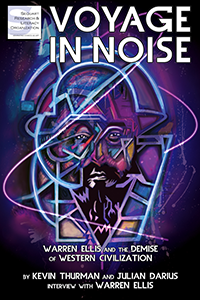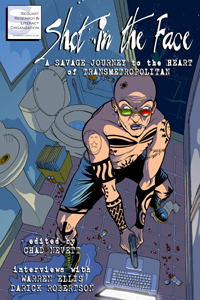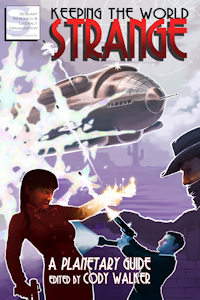Ultimate X-Men #24
Marvel Comics – Mark Millar (w); Kaare Andrews (a)
There used to be a time that I really looked forward to Ultimate X-Men. During the first two story arcs, I think the title exemplified the purpose of the Ultimate line, taking traditional stories and giving them a more modern or mature spin. Sometimes the relationships of the characters were the same (or as close as makes any difference) in the Ultimate universe as they were in the mainstream Marvel, sometimes the dynamics changed (though whether they were for the better or for the worse was a subject of debate amongst some readers, X-Men fans being the most terrified of change of all fanboy groups).
However, since Ultimate X-Men #12, I think the book has begun a slow spiral downward. This is not to say that the book has not shown flashes of Millar’s trademark brilliance; rather, the story arcs themselves have begun to be a bit more mundane, treading over too much familiar ground and spinning out fewer new concepts than previously. Case in point, the current Dark Phoenix arc.
There have been some really entertaining moments in this arc so far (the Cyclops and Wolverine fight springs immediately to mind), it has also been plagued by what I can only characterize as a lack of focus. There are a lot of interesting character bits and a passable super-powered plot, but there’s simply too much going on for it to be all that impressive.
To be really blunt about it, the villain of the arc (revealed this issue) is a complete letdown. All this time spent building up a mysterious opponent only to reveal that it’s a previously unmentioned supercomputer that can inexplicably animate the dead. It’s made worse by the fact that the computer and Cyclops and Wolverine are apparently familiar with each other from their respective times in the Savage Land, but as a reader, I can’t say that I recognize the concept. To boot, there’s absolutely not logic behind how a computer can raise the dead, and it’s made even sillier by some sort of half-baked “technological mutation” concept that the machine invents. I realize looking for logic in a book that regularly uses the phrase “world’s most powerful psychic” and features super-powered mutants is a futile gesture, but it still irks me.
Compound all this with a predictable lawsuit subplot featuring Iceman, the seesaw control / lack of control sequences with Jean and the Phoenix Force, and the appearance of the Hellfire Club and there’s simply too much going on. To be perfectly honest, it feels like Millar took the better portion of Chris Claremont and John Byrne’s Uncanny X-Men run’s plots and smashed them all together into one arc. It’s just rather rushed and sloppy.


 .
.
Mek #1
DC Comics / Homage Comics – Warren Ellis (w); Steve Rolston (p); Al Gordon (i)
These days, you’ve got to take your Warren Ellis where you can find it. With Transmetropolitan wrapping it’s run up and Planetary sadly languishing in some sort of corporate limbo, you’re left with few options for Ellis’ work. Even fewer if you (like myself) generally ignore the work that he does for Avatar Press. So it was with a bit of nervousness that I looked forward to his upcoming barrage of work for DC (beginning with the excellent Global Frequency and continuing with this series). Thankfully, thus far, none of his new burst of creativity for the Distinguished Competition has disappointed.
Maybe it’s my increasing desire to get a tattoo (and, if I’m being perfectly honest, I probably wouldn’t stop at one if I got one at all), but I find myself more interested by the body piercing/modification culture that this book centers around than I would have previously thought. I planned to pick the book up, regardless of its plot synopsis in Previews because a) I like Ellis and b) I like grim sci fi stories and this look vaguely Blade Runner-esque, but I’m really feeling justified in having bought this now. Previously, it was just a book that I looked at and said to myself, “Eh, it’s new Ellis. I’ll pick all three up regardless.” And you ask, “Why?” Because it’s rather good.
Even though there isn’t a lot going on here, because it’s the set-up issue of a three-issue mini, what is going on is absolutely cool. There are a lot of undertones running through the issue, from dealing with your own increasing age to the technology piracy culture to youth in corporately packaged rebellion. And it’s all done in a sort of futuristic noir setting, making my earlier comparison to Blade Runner particularly accurate.
What we have is essentially a classic noir murder mystery, but twisted to fit into a radically different (though still eerily similar, in some respects) setting. And it absolutely works. Pick it up, it’s worth the read alone, but Steve Rolston (who was the subject of much complaint by readers when he penciled Queen and Country) turns in a fine performance on the pencil duties.




 .
.
War Story: The Reivers
DC Comics / Vertigo – Garth Ennis (w); Cam Kennedy (a)
I loved last year’s batch of War Story issues and thought that three out of the four were fan-fricking-tastic (I wasn’t terribly impressed with Nightingale, for the record). So, much like this week’s release of Mek, I was also really looking forward to this first offering of the series of one-shots. So, Sunday evening rolled around and I took a look at thefourthrail.com’s First Look Reviews and was shocked to see that they were none too impressed with The Reivers. Now, I don’t know what exactly their reasons were (because I try not to read other people’s reviews, but I do look at their ratings each week), but I was skeptical. However, having read The Reivers now, I can’t say that I disagree with them. It’s not exactly the best way to start the new run off.
The last batch of War Story issues was solid primarily because they each focused on one particular element of war. Screaming Eagles dealt with finding comfort amidst the slaughter; D-Day Dodgers focused on duty and sacrifice, particularly those sacrifices that go unappreciated and unheralded. You get the idea. The point is that there was a definite focus to each issue and it worked. The Reivers, however, can’t seem to decide what exactly its purpose is. Initially, it seems to be about camaraderie amongst commandos, but it shifts to this half-baked metaphor about how the fast attack division is the modern day equivalent of medieval Scottish bandits (the titular Reivers). Which is all fine and good, I suppose, but it takes another twist at the end, a decidedly anti-war turn. But the final turn comes rather late in the issue and a few pages later, it’s over. It’s just schizophrenic, really.
This is not to say that War Story: The Reivers is bad. It’s simply not nearly as good as I expected it to be. The one hope that I have, however, is that last year’s run seemed to continually improve each month, with the exception of the final issue, Nightingale. So even if The Reivers was a bit of a let-down, I’m sure the series as a whole will come together nicely. To boot, DC is apparently not going to collect them in trade (as they still haven’t made mention of collecting last year’s issues), so it’s either read them now or don’t read them at all for me. And since I’ll take a war book any day over another Spider-Man or X-Men book, I can’t be too upset.


 .
.
Daredevil / Bullseye: The Target #1
Marvel Comics – Kevin Smith (w); Glenn Fabry (a)
This issue proved several things for me.
- Glenn Fabry is a nice penciller, but a much better cover painter.
- All Marvel really cares about is promoting their movies.
- Marvel mini-series are still a complete waste of time.
- Kevin Smith is a terribly uneven comic book writer.
There’s not a lot of story here, so there consequently won’t be a lot of review.But here’s what we have, nonetheless. Essentially, this mini is two things: 1) an excuse for an extended fight scene between Daredevil and Bullseye and 2) a vehicle for transitioning Bullseye between his traditional costume and his movie costume (which is, as per Marvel standard, a Matrix-style costume). That’s it, really. Aside from a plethora of anti-Arab remarks by several characters and a token, cookie-cutter terrorism “plot,” nothing else really happens. Sure, we get to see what a cold-blooded psychopath Bullseye is, but hasn’t Frank Miller already done that repeatedly (not to mention better)?
Maybe the rest of the mini can redeem this first issue, which fell completely on its face, but I doubt it.

 .
.
Vertigo Pop: London #1
DC Comics / Vertigo – Peter Milligan (w); Phillip Bond (a)
I make no secret of the fact that I think Vertigo Pop: Tokyo was a complete waste of time and Seth Fisher’s talent. However, the only reason I picked up Tokyo to begin with was because it preceded the one that I really wanted, London, and I was under the impression that there would be some sort of connection between the three minis. I was wrong about that, because they have nothing to do with each other (thank God, because I’m not sure that I’d want the taint of Vertigo Pop: Tokyo on London), but thankfully London turns out to be everything I thought it’d be, plus a fun twist at the end that really left me looking forward to the next issue.
The story is a simple one. An aging Mick Jagger clone endures his sixtieth birthday and reflects on the life that he used to have and the life that he currently leads. During that day, he finds two things: a video that he made for himself on his thirtieth birthday, to be watched on his sixtieth (containing a secret that leads to the twist ending) and a jealousy for a smarmy British rocker (parodying Noel Gallagher rather nicely) that he was previously unaware of.
This is essentially a book about coming to grips with your own mortality, in a fashion, at least for the first issue. I’ll not spoil the surprise of the final page, but be forewarned: when I review later issues, I will assume that anyone reading has either read the first issue or doesn’t intend to read at all. But I don’t want to ruin the ending now, it’s that much fun. Suffice it to say that I highly recommend picking the book it.




 .
.
Fables #7
DC Comics/Vertigo – Bill Willingham (w); Mark Buckingham (p); Steve Leialoha (i)
I’m beginning to run out of ways to recommend this book to people at my store. At this point, if you’ve at least tried the book, I feel sorry for you, because it’s really good.
This issue continues the Animal Farm arc, which has in two issues surpassed the sum total of the previous five. In addition to being just generally really creepy, Animal Farm leaves Bigby Wolf (the protagonist of the first story arc) at home in New York City and focuses on Snow White and Rose Red. Snow White was fairly fleshed out in the first story as well, so she’s basically a supporting character in this arc, but it works. As well, Rose Red is finally given a bit more depth, as she’s the central human character of this issue.
There’s a lot of tension building in just two issues and I honestly don’t know how this will end. That’s the real beauty of books like Fables. If this were Batman or something, we’d all know already how it ends: Batman wins and maintains the status quo. But Willingham can do whatever he wants with these characters. For all intents and purposes, they’re his. And that gives the book real suspense.




 .
.

























































